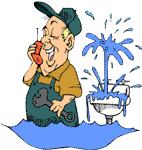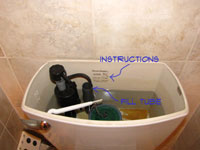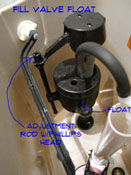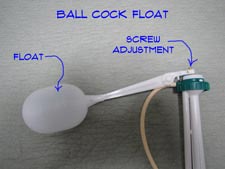 A toilet tank not filling correctly can cause problems with how the toilet flushes. Toilets need a certain amount of water to work properly, too little water and the toilet will clog or flush slowly.
A toilet tank not filling correctly can cause problems with how the toilet flushes. Toilets need a certain amount of water to work properly, too little water and the toilet will clog or flush slowly.
It may make economic sense to lower the water level in the tank, to save money. However, it does not make good toilet flushing sense.
Too little water in the tank can cause the flush slowly or not at all. This will cause the toilet to clog and create and unpleasant situation. Toilets are engineered to work with a certain amount of water. Make sure that when the tank fills it is near the top of the tube for the flush valve.
See the article 'How to Fix a Toilet' if this is not your problem, it covers all of the toilet repair topics.
Toilets are designed to use a certain amount of water to flush. With the water consumption limitations imposed by the government, all of that water is needed for the toilet to work properly. Reducing the level in the tank will cause the toilet to flush poorly. A 'slow flushing toilet' is a sign of too low a water level.
What Is the Proper Toilet Tank Water Level?
With the lid taken off you should be able to see a round vertical tube in the center of the tank. It will have the toilet flapper and a fill tube attached to it. The vertical tube is part of the toiltet flush valve.
The proper water level for most tanks is near the top of that vertical tube. Some tanks will have a line and an indication that is is the 'fill line'. If you have markings inside your tank, you want make sure the water is set to that level.
 For tanks with no markings, you will set the water level just below the top of the fill tube. Stay about 1/2" down from the top. You do not want to get too close to the top, otherwise it will run over and trickle into the tank.
For tanks with no markings, you will set the water level just below the top of the fill tube. Stay about 1/2" down from the top. You do not want to get too close to the top, otherwise it will run over and trickle into the tank.
Adjusting a Toilet Fill Valve
 When you look into the toilet tank you will see off to one side another vertical elment the has a built in float on it. It will also have a tube that is connects it to the fill tube in the center. The bottom of this assembly is connected to the water supply line for the toilet.
When you look into the toilet tank you will see off to one side another vertical elment the has a built in float on it. It will also have a tube that is connects it to the fill tube in the center. The bottom of this assembly is connected to the water supply line for the toilet.
This is the fill valve. The fill valve has a float on it that can be adjusted to set the water level in the tank. Most fill valves have a float that slides up and down on the vertical fill valve. There is a retaining clip or a screw device that allows for adjustment.
When the water is too low in the tank, you want to raise it. Simple, right? Yes it is, fortunately, the float adjusts the same way the water needs to go. To raise the water level, raise the float. To lower the water, lower the float.
A fluidmaster vertical fill valve will have an adjustment shaft with a phillips screw inset at the top. Turn the shaft clockwise to raise and counterclockwise to lower. Older ones will have a metal shaft with a spring clip on it. Pinch the spring clip and raise or lower the float as desired.
Adjusting a Toilet Ball Float
 Some toilets will have a ball cock that acts as a float. This will be connected to a horizontal rod that is connected to the fill valve. There will be a adjustment screw where the rod connects to the fill valve.
Some toilets will have a ball cock that acts as a float. This will be connected to a horizontal rod that is connected to the fill valve. There will be a adjustment screw where the rod connects to the fill valve.
To raise the water level you want to raise the float. Adjust the set screw or the clip on the float.The direction to turn the screw will depend on the design of the float valve. You may have to experiment a little to determine whether you are raising or lowering the float. The same rules apply with floats, raise it to raise the water level and lower it to lower the water level.
Checking the Toilet Tank Water Level
Before you pat yourself on the back for a job well done, you want to do a couple of test runs. Flush the toilet and let it fill back up.
It should stop filling at the mark on the tank or just below the top of the fill tube (approximately 1/2" below the top). If it fills too high it will start trickling into the fill tube and down into the toilet, wasting water. Make corrections as needed.
Check the water level on your tank periodically to make sure that it continues to fill properly. This will help to avoid toilet clogs and noisy water wasting situations.

